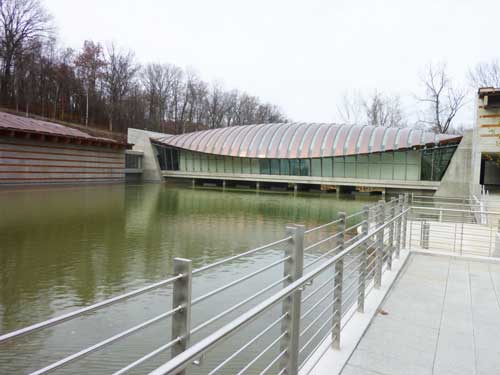

Completed: Crystal Bridges’ Lower Pond
As CultureGrrl readers may remember, I skipped last month’s press preview for Alice Walton‘s new Crystal Bridges Museum of American Art. I decided to wait until after its Nov. 11 public opening, expecting that by then it would be entirely finished.
Close, but not quite.
Aside from the upper pond, which I’m told will be filled with water in about a week, construction and installation of this much anticipated new cultural oasis in Bentonville, AR, have at last attained completion. Having seen the chaotic construction site last May, I was amazed by the transformation.
For the most part, I greatly admired what I saw. That said, I sometimes felt that the architecture and the art were engaged in a not always friendly sparring match, in which the art was sometimes the loser. (More on that in a later post.)
Below is one view of the sometimes disjointed layout. (That’s Dennis Miller Bunker‘s “Anne Page,” 1887, at the far end.)

But Alice’s Palace is, overall, an arresting, rewarding creation. However it stacks up against the great public collections of American art, Crystal Bridges is undeniably a great boon for its art-starved region. The totality of its holdings is not “World Class,” as some headline writers would have it. But it is, as founding curator Chris Crosman described it to me during my visit, “a credible collection,” with its fair (or sometimes unfair) share of masterpieces.
It does something else extremely well—invite less well-known artists into the American-art narrative. These bit players, more often than not, hold their own against the superstars. For example, hanging side-by-side in the galleries are these Western landscapes by the well known Moran and the lesser known Keith:

Thomas Moran, “Green River, Wyoming,” 1878

William Keith, “Sentinel Rock, Yosemite,” 1872
For me, the most fun during my two-day gallery ramble came both from making these unexpected discoveries of less familiar names and from coming upon the previously unannounced works that added more depth and breadth to Crystal Bridges’ collection than I had anticipated.
The official reason for not pre-releasing the full list of acquisitions was to allow an element of surprise for the opening. But another reason (as curator Kevin Murphy candidly told me when we chatted in Crystal Bridges’ light-filled, suspension-bridge restaurant) was the fact that museum officials had become (in Murphy’s words) “gun shy,” due to criticism (including mine) of Alice Walton‘s acquisition practices at the beginning of her intense, six-year buying spree on behalf of the museum.
But now let’s give credit where credit is due: Having conceived and bankrolled Crystal Bridges, Alice Walton chose not to make this project about herself. There’s no photo of, let alone tribute to, the founder/donor—a bit of self-aggrandizement that has come to be standard practice at other single-donor cultural enterprises. (Alice’s nephew did, however, get a starring role in the video on the museum’s homepage that I have previously debunked: I’ve now been told that the lead bicyclist in that mock-serious drama is Tom Walton.)
Hoping to attract broad-based contributions (in both cash and art) to her brainchild, Walton refrained from naming the museum for herself. Unlike other single-collector museums (think Barnes, Terra), this one was endowed so munificently by its founder as to insure its financial longevity. In many ways, Crystal Bridges’ benefactor, with the help of savvy advisers, did it right.
Below is a first look at the museum’s weathering (as anticipated) exterior, its lobby (which contains a surprising feature) and the first galleries in the sprawling permanent-collection installation, “Celebrating the American Spirit,” consisting of about 450 works, spanning the 18th to 21st centuries. (The checklist of its highlights is here.)
I’ll have more video and commentary in the future. For now, come explore with me the Moshe Safdie-designed exterior and let’s also begin our peregrination inside. (Stay tuned for Part II.)
